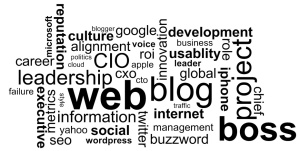 A basic requirement for entry into senior roles within the Federal Government you must provide evidence of progressively responsible leadership experience that is indicative of senior executive level management capability. The information below was taken from the USAJobs.gov website. Every leader, whether or not they are looking for a job in government should be able to answer these questions. It should also be used to rate a CIOs performance.
A basic requirement for entry into senior roles within the Federal Government you must provide evidence of progressively responsible leadership experience that is indicative of senior executive level management capability. The information below was taken from the USAJobs.gov website. Every leader, whether or not they are looking for a job in government should be able to answer these questions. It should also be used to rate a CIOs performance.
ECQ #1 – LEADING CHANGE: This core qualification involves the ability to bring about strategic change, both within and outside the organization, to meet organizational goals. Inherent to this ECQ is the ability to establish an organizational vision and to implement it in a continuously changing environment.
Leadership Competencies:
1. Creativity and Innovation. Develops new insights into situations; questions conventional approaches; encourages new ideas and innovations; designs and implements new or cutting edge programs/processes.
2. External Awareness. Understands and keeps up-to-date on local, national, and international policies and trends that affect the organization and shape stakeholders’ views; is aware of the organization’s impact on the external environment.
3. Flexibility. Is open to change and new information; rapidly adapts to new information, changing conditions, or unexpected obstacles.
4. Resilience. Deals effectively with pressure; remains optimistic and persistent, even under adversity. Recovers quickly from setbacks.
5. Strategic Thinking. Formulates objectives and priorities, and implements plans consistent with the long-term interests of the organization in a global environment. Capitalizes on opportunities and manages risks.
6. Vision. Takes a long-term view and builds a shared vision with others; acts as a catalyst for organizational change. Influences others to translate vision into action.
ECQ #2 – LEADING PEOPLE: This core qualification involves the ability to lead people toward meeting the organization’s vision, mission, and goals. Inherent to this ECQ is the ability to provide an inclusive workplace that fosters the development of others, facilitates cooperation and teamwork, and supports constructive resolution of conflicts.
Leadership Competencies:
1. Conflict Management. Encourages creative tension and differences of opinions. Anticipates and takes steps to prevent counter-productive confrontations. Manages and resolves conflicts and disagreements in a constructive manner.
2. Leveraging Diversity. Fosters an inclusive workplace where diversity and individual differences are valued and leveraged to achieve the vision and mission of the organization.
3. Developing Others. Develops the ability of others to perform and contribute to the organization by providing ongoing feedback and by providing opportunities to learn through formal and informal methods.
4. Team Building. Inspires and fosters team commitment, spirit, pride, and trust. Facilitates cooperation and motivates team members to accomplish group goals.
ECQ #3 – RESULTS DRIVEN: This core qualification involves the ability to meet organizational goals and customer expectations. Inherent to this ECQ is the ability to make decisions that produce high-quality results by applying technical knowledge, analyzing problems, and calculating risks.
Leadership Competencies:
1. Accountability. Holds self and others accountable for measurable high-quality, timely, and cost-effective results. Determines objectives, sets priorities, and delegates work. Accepts responsibility for mistakes. Complies with established control systems and rules.
2. Customer Service. Anticipates and meets the needs of both internal and external customers. Delivers high-quality products and services; is committed to continuous improvement.
3. Decisiveness. Makes well-informed, effective, and timely decisions, even when data are limited or solutions produce unpleasant consequences; perceives the impact and implications of decisions.
4. Entrepreneurship. Positions the organization for future success by identifying new opportunities; builds the organization by developing or improving products or services. Takes calculated risks to accomplish organizational objectives.
5. Problem Solving. Identifies and analyzes problems; weighs relevance and accuracy of information; generates and evaluates alternative solutions; makes recommendations.
6. Technical Credibility. Understands/appropriately applies principles, procedures, requirements, regulations and policies related to specialized expertise.
ECQ #4 – BUSINESS ACUMEN: This core qualification involves the ability to manage human, financial, and information resources strategically.
Leadership Competencies:
1. Financial Management. Understands the organization’s financial processes. Prepares, justifies, and administers the program budget. Oversees procurement and contracting to achieve desired results. Monitors expenditures and uses cost-benefit thinking to set priorities.
2. Human Capital Management. Builds and manages workforce based on organizational goals, budget considerations, and staffing needs. Ensures that employees are appropriately recruited, selected, appraised, and rewarded; takes action to address performance problems. Manages a multi-sector workforce and a variety of work situations.
3. Technology Management. Keeps up-to-date on technological developments. Makes effective use of technology to achieve results. Ensures access to and security of technology systems.
ECQ #5 – BUILDING COALITIONS: This core qualification involves the ability to build coalitions internally and with other Federal agencies, State and local governments, nonprofit and private sector organizations, foreign governments, or international organizations to achieve common goals.
Leadership Competencies:
1. Partnering. Develops networks and builds alliances; collaborates across boundaries to build strategic relationships and achieve common goals.
2. Political Savvy. Identifies the internal and external politics that impact the work of the organization. Perceives organizational and political reality and acts accordingly.
3. Influencing/Negotiating. Persuades others; builds consensus through give and take; gains cooperation from others to obtain inform







